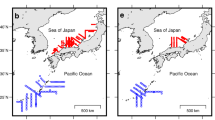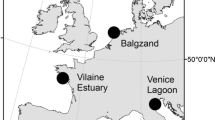Summary
We proffer a hypothesis on the influence of temperature during gonadal maturation on the spawning time, recruitment, and distribution of fish. The approach is based on the assumption that gonadal maturation starts at a certain date and requires a certain temperature sum [‡C · days]. The fish spawn when the particular temperature sum since the starting date has been reached. According to our approach, regional variability in the spawning time of dab(Limanda Limanda) and lemon sole(Microstomus kitt) can be attributed to regional temperature differences.
Our calculations indicate that, due to interannual temperature changes, the time of peak spawning of dab in the German Bight may vary interannually between the end of March and mid-June. In addition, the abundance of 0-year plaice(Pleuronectes platessa) from the German Bight is negatively correlated with temperature during gonadal maturation and during the development of early life stages of plaice(α < 1%), indicating a temperature recruitment relationship in terms of our hypothesis. We suppose that the spawning time of plaice is delayed when winter temperatures are low. Due to the delay, in the case of 0-group plaice from the German Bight, the environmental conditions that determine the survival of the progeny might become more convenient.
Assuming that fish species prefer a certain time of the year for spawning, we can further estimate its potential distribution area as a function of temperature. The results indicate that in the range between 1.5 and 14 ‡C mean temperature for eurytherm fish species, three geographically separated potential distribution areas can be distinguished among which the spawning times are delayed by 12 and 24 months respectively. This theoretical pattern may explain why dab (Limanda limanda) is abundant in the central and southern North Sea (temperate) as well as in the Barents Sea (subarctic). From our calculations we draw the conclusions that, in terms of our hypothesis, short-term interannual temperature changes may result in recruitment changes, and long-term temperature changes may shift the potential distribution area of a species towards either cooler or warmer regions.
Zusammenfassung
In dieser Arbeit stellen wir eine Hypothese vor, mit der wir die Wassertemperatur wÄhrend der Gonadenreifung in Beziehung setzen zur Laichzeit, Bestandsentwicklung und Verbreitung von Fischen. Der dargestellte Ansatz basiert auf der Annahme, da\ die Gonadenreifung zu einem bestimmten Zeitpunkt im Jahr beginnt, und da\ sie eine bestimmte Temperatursumme [Tag · ‡C] benötigt. Die Fische laichen, wenn die betreffende Temperatursumme wÄhrend der Gonadenreifung erreicht wird. Mit Hilfe dieses Ansatzes kann die regionale VariabilitÄt in der Laichzeit von Klieschen (Limanda Limanda) und Limanden (Microstomus kitt) aus der Nordsee durch regionale Temperaturunterschiede erklÄrt werden.
Die Ergebnisse unserer Berechnungen zeigen, da\ die Mitte der Laichzeit der Kliesche temperaturbedingt interannuell um bis zu 12 Wochen von Ende MÄrz bis Mitte Juni schwanken kann. Au\erdem haben wir festgestellt, da\ die Abundanz von 0-jÄhrigen Schollen (Pleuronectes platessa) negativ mit der mittleren Temperatur korreliert ist, die wÄhrend der Gonadenreifung und der Entwicklung der Frühstadien herrscht (α < 1 %). Diese Beziehung deutet auf eine TemperaturabhÄngigkeit der Rekrutierung im Sinne unseres Ansatzes hin. Wir nehmen an, da\ sich die Laichzeit bei niedrigen Wassertemperaturen wÄhrend der Gonadenreifung verzögert. Im Falle der Schollen, die in der Deutschen Bucht aufwachsen, führt diese Verschiebung möglicherweise dazu, da\ sich die entsprechenden Aufwuchsbedingungen der Larven und der Jungfische verbessern. Berücksichtigt man, da\ Fische bevorzugt in einer bestimmten Jahreszeit laichen, dann lÄ\t sich mit Hilfe unseres Ansatzes auch “das potentielle Verbreitungsgebiet einer Fischart in AbhÄngigkeit von der Wassertemperatur abschÄtzen. Entsprechend unseren Ergebnissen kommen wir zu der Schlu\folgerung, da\ eurytherme Fischarten im Bereich zwischen 1.5 und 14 ‡C mittlerer Wassertemperatur verschiedene potentielle Laichgebiete finden können, die geographisch voneinander getrennt sind. Die Dauer der Gonadenreifung unterscheidet sich zwischen diesen Regionen temperaturbedingt um 12 beziehungsweise um 24 Monate. Dieses zunÄchst theoretische Ergebnis liefert uns eine ErklÄrung dafür, warum Klieschen einerseits in der zentralen und der südlichen Nordsee vorkommen, andererseits aber auch im Barentsmeer gefunden werden. Aus unseren überlegungen schlie\en wir, da\ kurzzeitige interannuelle TemperaturÄnderungen gemÄ\ unserem Ansatz zu Änderungen in der Bestandsentwicklung von Fischen führen können. Eine langjÄhrige Zunahme beziehungsweise Abnahme der Wassertemperatur könnte darüberhinaus zu einer Verschiebung des Verbreitungsgebietes zu kÄlteren beziehungsweise wÄrmeren Regionen führen.
Similar content being viewed by others
References
Alheit, J. andE. Hagen, 1997: Long-term climate forcing of European herring and sardine populations.Fish. Oceanogr.,6, 130–139.
Apstein, C., 1909: Die Bestimmung des Alters pelagisch lebender Fischeier.Mitt. Dt. Seefischereiver,R5, 364–373.
Bohl, H., 1957: Die Biologie der Kliesche (Limanda limanda L.) in der Nordsee.Ber. Dtsch. Wiss. Komm. Meeresforsch.,15, 1–57.
Brander, K. andP. C. F. Hurley, 1992: Distribution of early-stage atlantic cod (Gadus morhua), haddock (Melanogrammus aegiefinus), and witch flounder (Glyptopcephalus cynoglossus) eggs on the Scotian Shelf: a reappraisal of evidence on the coupling of cod spawning and plankton production.Can. J. Fish. Aquat. Sci.,49, 238–251.
Buch, E., S. A. Horsted andH. Hovgård, 1994: Fluctuations in the occurrence of cod in Greenland waters and their possible causes.ICES mar. Sci. Symp.,198, 158–174.
Burton, M. P. andD. R. Idler, 1984: The reproductive cycle in winter flounder,Pseudopleuronectes americanus (Walbaum).Can. J. Zool.,62, 2563–2567.
Cushing, D. H., 1969: The regularity of the spawning season of some fishes.J. Cons. Int. Explor. Mer,33, 81–92.
Cushing, D. H., 1978: Biological effects of climatic change.Rapp. P.-v. Réun. Cons. int. Explor. Mer,173, 107–116.
Cushing, D. H., 1990: Plankton production and year-class strength in fish populations: an update of the match/mismatch hypothesis.Adv. mar. Biol.,26, 249–293.
Cushing, D. H. andR. R. Dickson, 1976: The biological response in the sea to climatic changes.Adv. mar. Biol.,14, 1–122.
Daan, N., 1994: Trends in North Atlantic cod stocks: a critical summary.ICES mar. Sci. Symp.,198, 158–174.
Daan, N., P. J. Bromley, J. R. G. Hislop andN.A. Nielsen, 1990: Ecology of North Sea fish.Neth. J. Sea Res.,26, 343–386.
Deniel, C. andM. Tassel, 1986: Reproduction et croissance de la limande Limanda limanda (Linnaeus, 1758) (Téléostéen, Pleuronectidae) in Manche Orientale et Baie de Dournanez.Cybium,10, 155–176.
de Young, B. andG. A. Rose, 1993: On recruitment and distribution of Atlantic Cod (Gadus morhua) off Newfoundland.Can. J. Fish. Aquat. Sci.,50, 2729–2741.
Dippner, J., 1998: Recruitment success of different fishes in the North Sea in relation to climate variability.Dt. Hydrogr. Z., this vol.
Ellertsen, B., P. Fossum, P. Solemdal andS. Sundby, 1989: Relation between temperature and survival of eggs and first-feeding larvae of northeast Arctic cod(Gadus morhua L.).Rapp. P.-v. Réun. Cons. Int. Explor. Mer,191, 209–219.
Garrod, D. J. andJ. M. Colebrook, 1978: Biological effects of variability in the north Atlantic ocean.Rapp. P.-v. Réun. Cons. int. Explor. Mer,173, 128–144.
Hamel, P., P. Magnan, M. Lapointe andP. East, 1997: Timing of spawning and assessment of a degree-day model to predict the in situ embryonic developmental rate of white sucker,Catostomus commersoni. Can. J. Fish. Aquat. Sci.,54, 2040–2048.
Hansen, H. andE. Buch, 1986: Prediction of year-class strength of Atlantic cod(Gadus morhua) off West Greenland. NAFO Sci.Coun. Studies,10, 7–11.
Harding, D., J. H. Nichols andD. S. Tungate, 1978: The spawning of plaice(Pleuronectes platessa L.) in the southern North Sea and English Channel.Rapp. P.-v. Réun. Cons. Int. Explor. Mer,172, 102–113.
Heip, C., Basford, J. A. Craeymeersch, J.-M. Dewar-Umez, J. DvRjes, P. de Wilde, G. Duineceld, A. Eleftheriou, P. J. M. Herman, U. Niermann, P. Kingston, A. Künitzer, E. Rachor, H. Rumohr, K. Soetaert andT. Soltwedel, 1992: Trends in biomass, density and diversity of North Sea macrofauna.ICES J. mar. Sci.,49, 13–22.
Htun-Han, M., 1978. The reproductive biology of the dabLimanda limanda (L.) in the North Sea: gonosomatic index, hepatosomatic index and condition factor.J. Fish Biol.,13, 369–378.
Iles, T. D. andM. Sinclair, 1982: Atlantic herring: stock discreteness and abundance.Science,215, 627–633.
Laevastu, T., 1993: Marine climate, weather and fisheries: the effects of weather and climatic changes on fisheries and ocean resources. Blackwell Scientific Publications, Oxford, 204 pp.
Lee, C. K. C., 1972: The biology of the common dabLimanda limanda (L.) in the North Sea. Ph. D. thesis, University East Anglia.
Myers, R. A., G. Mertz andC. A. Bishop, 1993: Cod spawning in relation to physical and biological cycles of the northern North-west Atlantic.Fish. Oceanogr.,2 (3/4), 154–156.
Ortega-Salas, A. A., 1980: Seasonal changes in the common dab,Limanda limanda (L.) in the Isle of Man Waters.J. Fish Biol.,16, 75–82.
Page, F. H. andK. T. Frank, 1989: Spawning time and egg stage duration in northwest Atlantic haddock(Melanogrammus aeglefinus) stocks with emphasis on George and Browns Bank.Can. J. Fish. Aquat. Sci.,46, 68–81.
Podoskina, T. A., 1993: Morphology of supporting elements in jaw-pharyngeal apparatus of some pleuronectiform fishes in relation to feeding specializations.J. Ichtyoi,33, 122–128.
Pohlmann, T., 1996: Simulating the heat storage in the North Sea with a three-dimensional circulation model.Cont. Shelf Res.,16, 195–213.
Prosser, C. L. (ed.), 1991: Environmental and metabolic animal physiology. Wiley-Liss, New York, 578 pp.
Rae, B. B., 1965: The lemon sole. Fishing News (Books) Ltd., London, 106 pp.
Rüssel, F. S., A. J. Southward, G. T. Boalch andE.I. Butler, 1971: Changes in biological conditions in the English Channel off Plymouth during the last half century.Nature,234, 468–470.
Ruzzante, D. E., C. T. Taggart, D. Cook andS. Goddard, 1996: Genetic differentiation between inshore and offshore Atlantic cod(Gadus morhua) off Newfoundland: microsatellite DNA variation and antifreeze level.Can. J. Fish. Aquat. Sci.,53, 634–645.
Sinclair, M. andM. J. Tremblay, 1983: A new hypothesis to account for the timing of spawning of herring populations. ICES CM 1983/H:47.
Tomczak, G. andE. Goedecke, 1962: Monatskarten der Temperatur der Nordsee, dargestellt für verschiedene Tiefenhorizonte.Dt. hydrogr. Z., Erg.-H., B (7), 1–25.
van der Veer, H. W. andM. J. N. Bergman, 1987: Predation by crustaceans on a newly settled 0-group plaicePleuronectes platessa population in the western Wadden Sea.Mar. Ecol. Prog. Ser.,35, 203–215.
von Westernhagen, H. andV. Dethlefsen, 1997: The use of malformations in pelagic fish embryos for pollution assessment.Hydrobiologia,352, 241–250.
Walsh, S. J., 1994: Life history traits and spawning characteristics in populations of long rough dab (american plaice)Hippoglossoides platessoides (Fabricius) in the North Atlantic.Neth. J. Sea Res.,32 (3/4), 241–254.
Ware, D. M. andR. R. W. Tanasichuk, 1989: Biological basis of maturation and spawning waves in pacific herring(Clupea harengus pallasi).Can. J. Fish. Aquat Sci.,46, 1776–1784.
Author information
Authors and Affiliations
Corresponding author
Rights and permissions
About this article
Cite this article
Lange, U., Greve, W. Does temperature influence the spawning time, recruitment and distribution of flatfish via its influence on the rate of gonadal maturation?. Deutsche Hydrographische Zeitschrift 49, 251–263 (1997). https://doi.org/10.1007/BF02764037
Received:
Accepted:
Published:
Issue Date:
DOI: https://doi.org/10.1007/BF02764037




